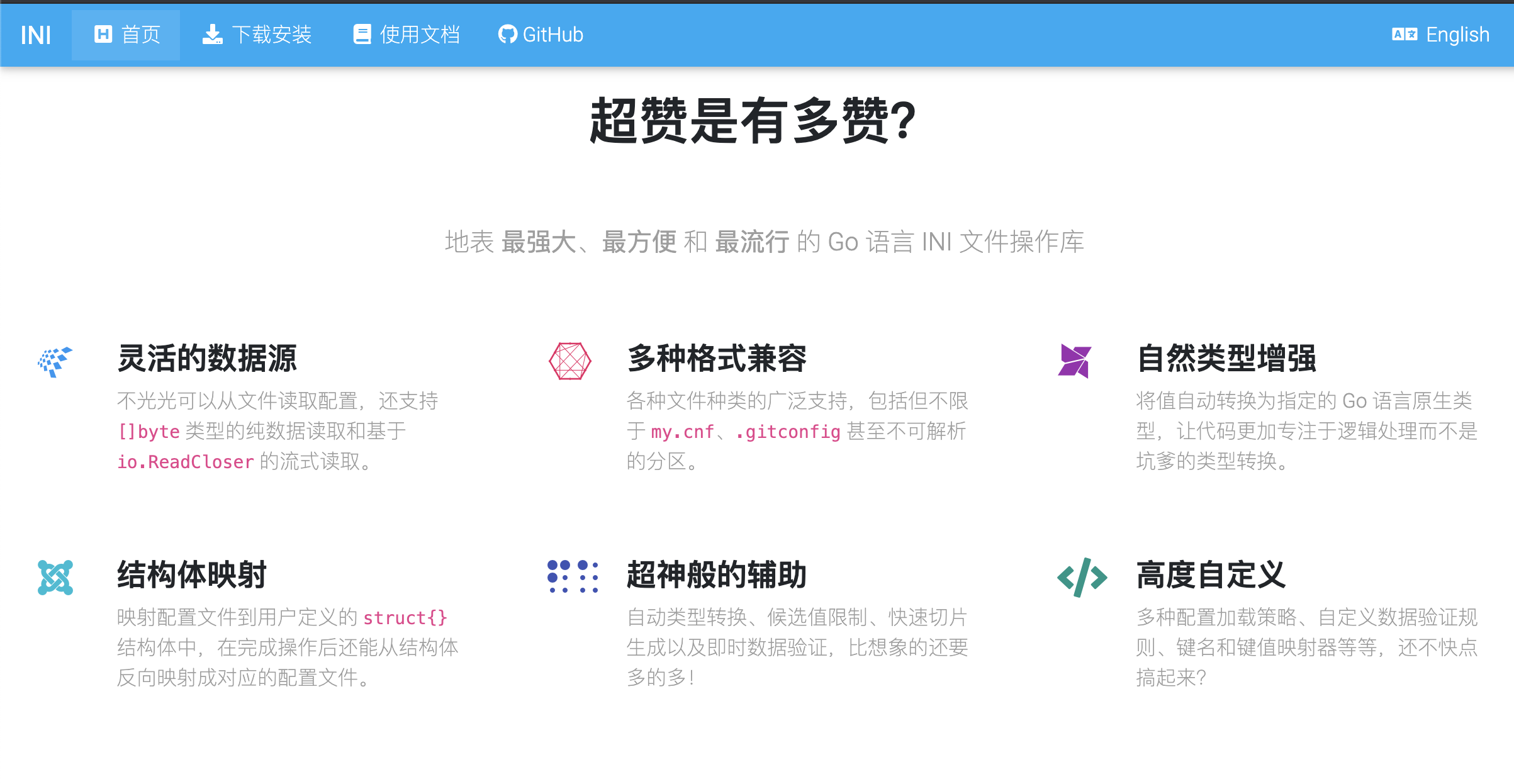如果你使用 INI 作为系统的配置文件,那么一定会使用这个库吧。没错,它就是号称地表 最强大、最方便 和 最流行 的 Go 语言 INI 文件操作库:https://github.com/go-ini/ini。
该项目的作者也是很多 Go 语言爱好者熟悉的无闻大师。讲真,文档都写的很好,很用心。官方网站:https://ini.unknwon.io/

功能特性
- 支持覆盖加载多个数据源(
[]byte、文件和io.ReadCloser) - 支持递归读取键值
- 支持读取父子分区
- 支持读取自增键名
- 支持读取多行的键值
- 支持大量辅助方法
- 支持在读取时直接转换为 Go 语言类型
- 支持读取和 写入 分区和键的注释
- 轻松操作分区、键值和注释
- 在保存文件时分区和键值会保持原有的顺序
下载安装
最低要求安装 Go 语言版本为 1.6。
$ go get -u gopkg.in/ini.v1
开始使用
我们将通过一个非常简单的例子来了解如何使用。
首先,我们需要在任意目录创建两个文件(my.ini 和 main.go),在这里我们选择 /tmp/ini 目录。
$ mkdir -p /tmp/ini
$ cd /tmp/ini
$ touch my.ini main.go
$ tree .
.
├── main.go
└── my.ini
0 directories, 2 files
现在,我们编辑 my.ini 文件并输入以下内容(部分内容来自 Grafana)。
# possible values : production, development
app_mode = development
[paths]
# Path to where grafana can store temp files, sessions, and the sqlite3 db (if that is used)
data = /home/git/grafana
[server]
# Protocol (http or https)
protocol = http
# The http port to use
http_port = 9999
# Redirect to correct domain if host header does not match domain
# Prevents DNS rebinding attacks
enforce_domain = true
很好,接下来我们需要编写 main.go 文件来操作刚才创建的配置文件。
package main
import (
"fmt"
"os"
"gopkg.in/ini.v1"
)
func main() {
cfg, err := ini.Load("my.ini")
if err != nil {
fmt.Printf("Fail to read file: %v", err)
os.Exit(1)
}
// 典型读取操作,默认分区可以使用空字符串表示
fmt.Println("App Mode:", cfg.Section("").Key("app_mode").String())
fmt.Println("Data Path:", cfg.Section("paths").Key("data").String())
// 我们可以做一些候选值限制的操作
fmt.Println("Server Protocol:",
cfg.Section("server").Key("protocol").In("http", []string{"http", "https"}))
// 如果读取的值不在候选列表内,则会回退使用提供的默认值
fmt.Println("Email Protocol:",
cfg.Section("server").Key("protocol").In("smtp", []string{"imap", "smtp"}))
// 试一试自动类型转换
fmt.Printf("Port Number: (%[1]T) %[1]d\n", cfg.Section("server").Key("http_port").MustInt(9999))
fmt.Printf("Enforce Domain: (%[1]T) %[1]v\n", cfg.Section("server").Key("enforce_domain").MustBool(false))
// 差不多了,修改某个值然后进行保存
cfg.Section("").Key("app_mode").SetValue("production")
cfg.SaveTo("my.ini.local")
}
运行程序,我们可以看下以下输出:
$ go run main.go
App Mode: development
Data Path: /home/git/grafana
Server Protocol: http
Email Protocol: smtp
Port Number: (int) 9999
Enforce Domain: (bool) true
$ cat my.ini.local
# possible values : production, development
app_mode = production
[paths]
# Path to where grafana can store temp files, sessions, and the sqlite3 db (if that is used)
data = /home/git/grafana
...
完美!这个例子很简单,展示的也只是极其小部分的功能,想要完全掌握还需要多读多看,毕竟学无止境嘛。
有疑问加站长微信联系(非本文作者)







